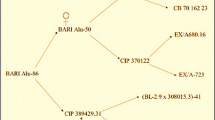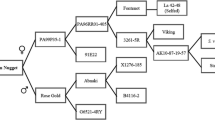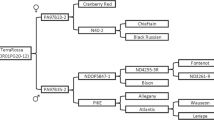Abstract
Purple Pelisse is a specialty ‘fingerling’ potato with purple skin and dark purple flesh. It has medium maturity and sets a large number of smooth, small, fingerling-shaped tubers. The tubers have medium specific gravity and high levels of antioxidants. This potato variety is mainly intended for the fresh market but it can also be used for processing; chips made from Purple Pelisse tubers retain their bright purple color and have a pleasant taste. Purple Pelisse is moderately resistant to common scab and potato virus Y and susceptible to most of the other common potato diseases. Purple Pelisse resulted from a cross between NDOP5847-1 and bulked pollen of red-fleshed potatoes. It was first selected from seedling tubers planted and grown at Madras, Oregon in 2001 and was subsequently evaluated for six additional years in public and industry trials throughout the western U.S, including Western Regional Red/Specialty Trials in 2006 and 2007. Purple Pelisse was officially released as a variety in 2009 by the Pacific Northwest (Tri-State) Potato Variety Development Program.
Resumen
Purple Pelisse es una papa de especialidad “tipo dedo” con piel morada y pulpa morada oscura. Es de madurez intermedia y produce un gran número de tubérculos suaves, pequeños, en forma de dedos. Los tubérculos tienen gravedad específica media y altos niveles de antioxidantes. Esta variedad se pretende que sea para el mercado fresco, aunque también puede usarse para proceso; las hojuelas de tubérculos de Purple Pelisse retienen su color morado brillante y tienen un sabor placentero. Purple Pelisse es moderadamente resistente a la roña común y al virus Y de la papa, y es susceptible a la mayoría de las otras enfermedades comunes de la papa. Purple Pelisse resultó de una cruza entre NDOP5847 y el polen mezclado de papas de pulpa roja. Primero se seleccionó de tubérculos de plántulas cultivadas en Madras, Oregon, en 2001, y fue evaluada subsecuentemente por seis años adicionales en ensayos públicos y de la industria en todo el oeste de los E. U., incluyendo ensayos de especialidades rojas regionales del oeste en 2006 y 2007. Purple Pelisse se liberó oficialmente como variedad en 2009 por el programa Tri-Estatal de Desarrollo de Variedades de Papa del Noroeste del Pacífico.


Similar content being viewed by others
Abbreviations
- RHSCC:
-
Royal Horticulture Society Color Chart
- PLRV:
-
Potato Leafroll Virus
- USDA:
-
United States Department of Agriculture
- ARS:
-
Agricultural Research Service
References
Brown, C.R., R. Wrolstad, R. Durst, C.-P. Yang, and B. Clevidence. 2003. Breeding studies in potatoes containing high concentrations of anthocyanins. American Journal of Potato Research 80: 241–250.
Corsini, D.L., J.J. Pavek, M.W. Martin, and C.R. Brown. 1994. Potato germplasm with combined resistance to leafroll virus and viruses X and Y. American Potato Journal 71: 377–386.
Dearborn, C. 1961. Stately: A high quality home gardener’s potato for Alaskans. American Journal of Potato Research 38: 244–248.
Durst, R.W., and R. Wrolstad. 2001. Separation and characterization of anthocyanins by HPLC. In Current protocols in food analytical chemistry, ed. R.E. Wrolstad, 1.3.1–1.3.13. NY: Wiley.
Feingold, S., J. Lloyd, N. Norero, M. Bonierbale, and J. Lorenzen. 2005. Mapping and characterization of new EST-derived microsatellites for potato (Solanum tuberosum L.). Theoretical and Applied Genetics 111: 456–466.
Ghislain, M., J. Núñez, M. Del Rosario Herrera, J. Pignataro, F. Guzman, and D.M. Spooner. 2009. Robust and highly informative microsatellite-based genetic identity kit for potato. Molecular Breeding 23: 377–388.
Holm, D.G., and F. Goktepe. 2009. Development of a grade standard for the breeding and selection of fingerling potato cultivars. American Journal of Potato Research 86: 135–164.
Johansen, R.H., E.P. Lana, and A.P. Bensen. 1964. Viking, a new high yielding, red skinned potato variety. American Potato Journal 41: 253–255.
Johansen, R., B. Farnsworth, J. Huguelet, D. Nelson, and E. Lana. 1977. Bison, a new red-skinned potato variety. American Journal of Potato Research 54: 189–193.
Johnston, G.R., and R.G. Rowberry. 1981. Yukon Gold: a new yellow-fleshed, medium-early, high quality table and french-fry cultivar. American Potato Journal 58: 241–244.
Knowles, N.R. and M.J. Pavek. 2007. WSU potato cultivar yield and postharvest quality evaluations for 2006. Washington State University Special Report. 128 pages. (methods on pp. 16–19; see http://potatoes.wsu.edu/documents/2007WSUPotatoCultivarBook.pdf)
Peryam, D.R., and F.J. Pilgrim. 1957. Hedonic scale method of measuring food preferences. Food Technology 11: 9–14.
Rosenthal, S., and S. Jansky. 2008. Effect of production site and storage on antioxidant levels in specialty potato (Solanum tuberosum L.) tubers. Journal of the Science of Food and Agriculture 88: 2087–2092.
Steffens, D.L., S.L. Sutter, and S.C. Roerner. 1993. An alternate universal forward primer for improved automated DNA sequencing of M13. Biotechniques 15: 580–581.
Wechsler, L. 2011. Acceptance of colorful fresh market potatoes: effects of sensory properties and Health Information M.S. thesis, Oregon State University, Corvallis, OR.
Acknowledgements
The authors thank Creighton Miller, David Holm, Roy Navarre, Jeanne Debons, Jenny Reed, Robert Smith, Lori Ewing, Margaret Bain, Nora Fuller, Zach Holden, Penny Tubbs, Darren Hall, Steve Wheeler, Mark Fristad, Charlene Miller, Brian Schneider, Michael Morrissey, Linda Wechsler, Catherine Durham, Cindy Lederer, Alex Stone and Chef Leif Eric Benson for their contributions to the development and release of Purple Pelisse. We also thank our industry cooperators, our collaborators in the Western Regional Potato Variety Trials, and the Idaho, Washington, and Oregon potato commissions. The Oregon Agricultural Experiment Station, the Oregon Potato Commission, the Potato Variety Management Institute (PVMI), the USDA Cooperative State Research, Education, and Extension Service, and the USDA Agricultural Research Service provided partial financial support for this research.
Author information
Authors and Affiliations
Corresponding author
Additional information
D. C. Hane S. R. James, A. R. Mosley: Retired from the Department of Crop and Soil Science, Oregon State University
Rights and permissions
About this article
Cite this article
Vales, M.I., Brown, C.R., Yilma, S. et al. Purple Pelisse: A Specialty ‘Fingerling’ Potato with Purple Skin and Flesh and Medium Specific Gravity. Am. J. Pot Res 89, 306–314 (2012). https://doi.org/10.1007/s12230-012-9254-3
Published:
Issue Date:
DOI: https://doi.org/10.1007/s12230-012-9254-3




